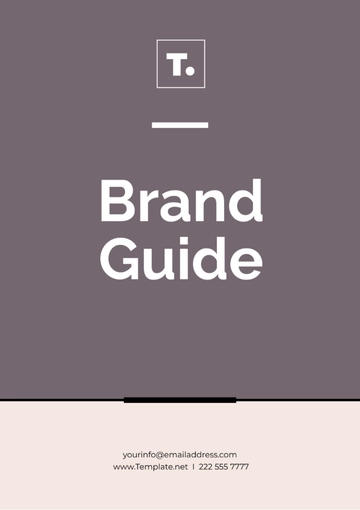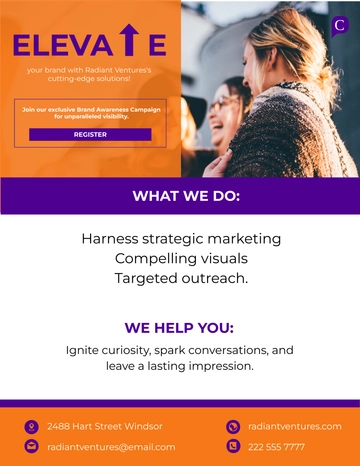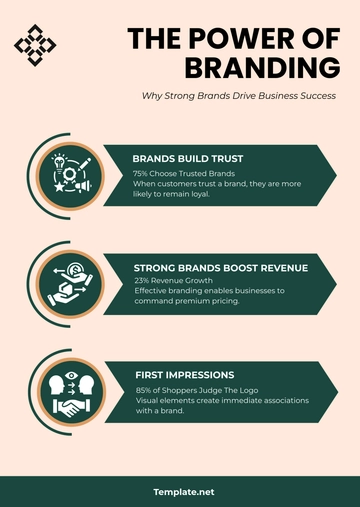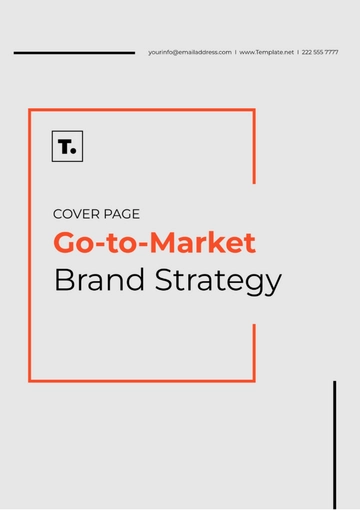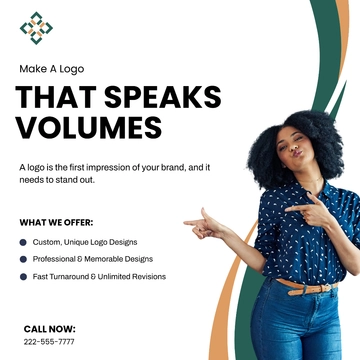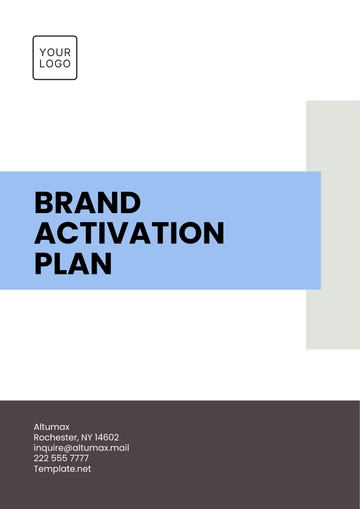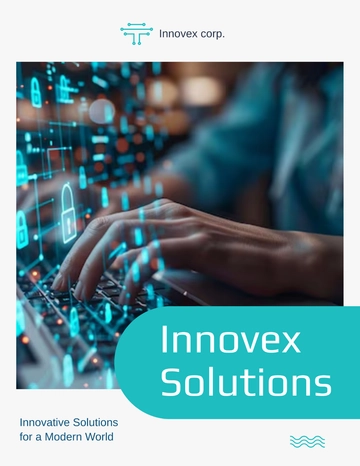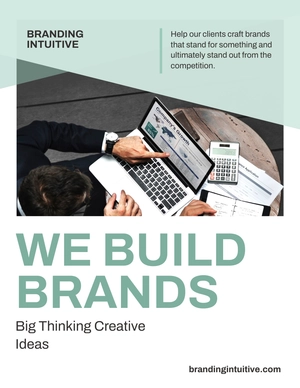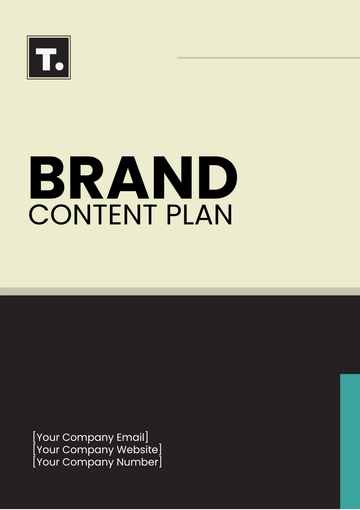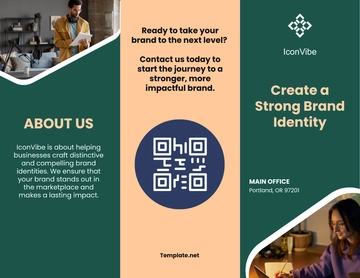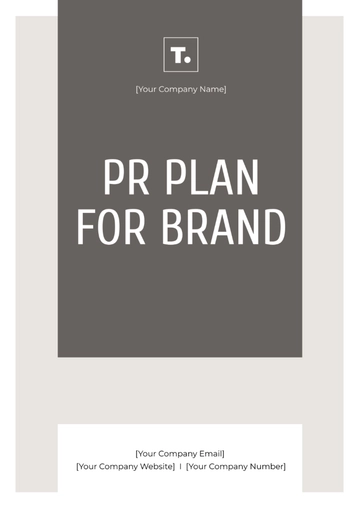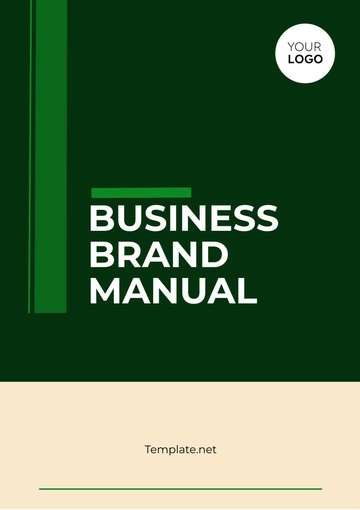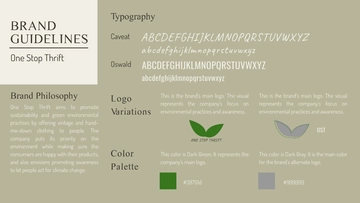Free Marketing User Guide for Brand Digital Assets
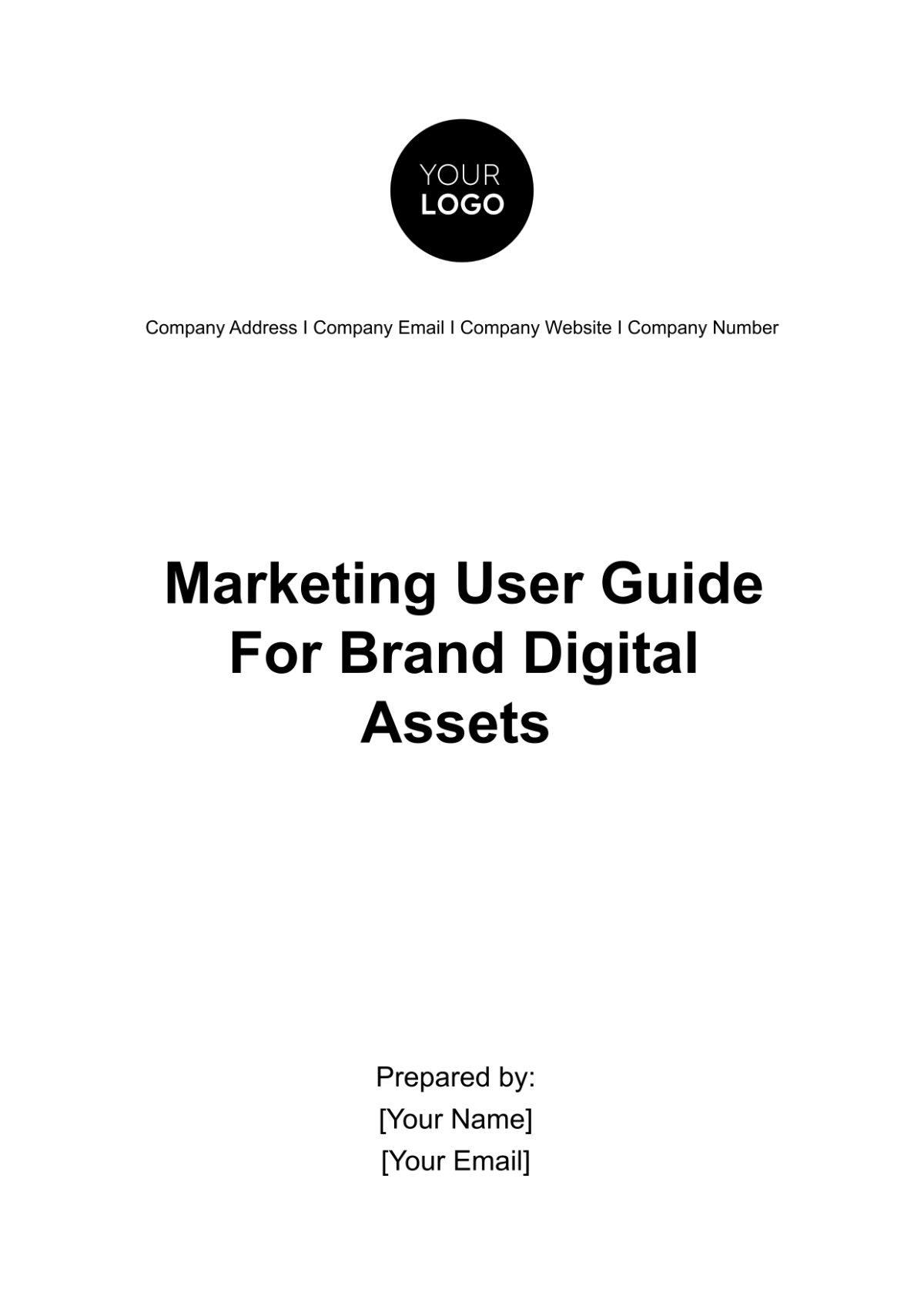
1. Introduction
Welcome to [Your Company Name]'s Marketing User Guide for Brand Digital Assets. This essential handbook is meticulously curated to provide our team and collaborators with straightforward directions on leveraging our brand's digital resources. From the novice marketer to the seasoned designer, everyone will find this guide an invaluable tool for navigating through our extensive digital asset collection. As [Your Company Name] continues to grow and evolve in the digital age, it's paramount that our brand representation remains consistent, recognizable, and impactful. Through this guide, we endeavor to offer clarity on the appropriate usage, access protocols, and maintenance procedures for our assets. By ensuring that all stakeholders adhere to these guidelines, we can project a unified and strong brand identity across all our platforms and communication channels. We trust this guide will serve as your go-to reference in all matters pertaining to our brand's digital assets.
2. Digital Asset Categories
In the vast realm of digital marketing, assets play a pivotal role in conveying a brand's message, identity, and values. Understanding these assets and their distinct categories can aid in optimizing their use for effective branding. Here, we delve deeper into each category, shedding light on their significance and unique features.
Logos: At the heart of every brand lies its logo, serving as an immediate visual identifier. Within [Your Company Name], variations of our logo are tailored for different applications. The primary logo is for general branding, while the secondary often offers a simplified or alternative design. For situations demanding a single-color representation, the monochromatic logo comes into play.
Images: Visuals are integral in telling a brand's story. Stock photos provide generic but high-quality imagery suitable for diverse uses. In-house photos capture the essence of our company, spotlighting genuine moments and events. Lastly, illustrations offer a creative avenue, often used to simplify complex ideas or add artistic flair to content.
Videos: Moving visuals encapsulate a narrative like no other. Corporate videos project our brand's ethos and vision. Product demos are instrumental in showcasing the functionality and benefits of our offerings. Advertisements, on the other hand, are tailored to engage, entertain, and persuade our target audience.
Typography: Fonts carry more than words; they convey mood, tone, and personality. At [Your Company Name], our typography guidelines ensure that every written word aligns with our brand's voice. From headline fonts to body text, each typeface has been chosen to enhance legibility and aesthetic appeal.
Templates: Consistency is key in professional presentations and documents. Our templates are pre-designed layouts for presentations, reports, and various other documents, ensuring that any material produced remains consistent with our brand's look and feel.
Color Palettes: Colors evoke emotions and create brand recognition. Our color palette is meticulously curated, comprising both primary and secondary shades. Each color is provided with its corresponding HEX, RGB, and CMYK codes, ensuring accuracy across digital and print mediums.
With this deeper understanding of our digital asset categories, [Your Company Name] ensures that every piece of content produced resonates with our brand's vision and ethos.
3. Accessing Digital Assets
In our digital age, efficient and secure access to brand assets is crucial for seamless marketing operations. At [Your Company Name], we have streamlined the process, ensuring that team members can quickly retrieve the resources they need, all while maintaining the highest level of security. Below is a concise guide on how to access our repository of digital assets.
A. Navigate to the Digital Asset Management System:
Begin by opening your preferred web browser. Enter the following URL into the address bar: [Digital Asset Management System URL]. This link will redirect you to our centralized digital asset management system, housing all our brand's resources.
B. Log In to the System:
Upon reaching the landing page of our Digital Asset Management System:
Locate and click on the 'Login' or 'Sign In' button, typically situated at the top-right corner of the page.
A login prompt will appear. Enter the following credentials:
Username: [Username]
Password: [Password]
Ensure you type the details accurately, taking note of any case sensitivity.
C. Begin Browsing:
Once logged in, you'll have access to our comprehensive library of digital assets. Utilize the search bar or navigate through categories to find the specific assets you need.
Important Reminders:
Always ensure you log out after completing your session, especially if accessing from a public or shared computer.
Keep login credentials confidential. Do not share them via email or any other insecure method.
If you face any issues or forget your login details, contact our support team immediately for assistance.
With this guide, accessing [Your Company Name]'s digital assets becomes a hassle-free experience, ensuring you have the right tools at your fingertips when you need them.
4. Using Brand Assets
In our quest for brand consistency and effective communication, understanding the appropriate application of our digital assets is imperative. This chapter delves into the distinctive categories of logos and images, highlighting their specific variations or types. Accompanied by a comprehensive table, we present clear use-cases and usage guidelines for each, ensuring that every visual representation aligns seamlessly with [Your Company Name]'s brand ethos.
Digital Asset Guidelines Table
Category | Type/Variation | Use-Case | Usage Guideline |
Logos | Primary | Main branding, large scale displays, and events. | Always use for official and primary brand representation. Ensure clear space and correct color palette. |
Secondary | Alternative scenarios where primary isn't fitting. | Use in situations where the primary logo feels out of place or is less visible. Consider backgrounds and aesthetics. | |
Monochromatic | Grayscale printing, certain merchandise, and minimalistic designs. | Ideal for black & white scenarios, or when a single color representation is needed. Avoid colorful backgrounds. | |
Images | Stock photos | For generic content on [Company] sites. | Suitable for general web content. Ensure they align with brand tone and are contextually appropriate. |
In-house photos | Specific branding and campaigns. | Prioritize for authentic representation of [Company] culture, events, or products. Always credit if required. | |
Illustrations | Creative content, infographics, etc. | Implement a stylized or abstract representation. Must adhere to brand colors and style. |
This table serves as a handy reference, ensuring that the visual components of [Your Company Name] are consistently and effectively portrayed across all mediums and platforms. Always refer back to this table when in doubt about which asset to use in a particular scenario.
5. Branding Dos and Don’ts
Branding is much more than just a visual representation of a company; it embodies its ethos, vision, and values. It's a language spoken without words, and like any language, there are rules to ensure its power and authenticity aren't diluted. This chapter illuminates the fundamental dos and don’ts of branding for [Your Company Name], ensuring that every piece of content we produce resonates with our core identity and communicates our message clearly and consistently.
Dos:
Always follow the color palette when designing any branded content.
The color palette of [Your Company Name] has been meticulously curated to reflect our brand's personality and values. Staying true to these colors ensures consistency and reinforces brand recognition across all platforms.
Use typography as specified.
Typography isn't just about readability; it's a subtle yet powerful tool that communicates our brand's voice. Adhering to our specified fonts and styles guarantees that all content resonates with the desired brand tone, ensuring a harmonious visual experience for the audience.
Ensure logo clear space (distance from other elements) is maintained.
A logo's impact isn't just in its design but also in its presentation. By ensuring adequate clear space around our logo, we let it breathe and stand out, preserving its prominence and legibility in any context.
Don'ts:
Do not stretch or deform logos.
Distorting our logo not only reduces its aesthetic appeal but also compromises brand recognition. Always ensure that the logo maintains its original proportions, regardless of where it's placed or how it's used.
Avoid using non-branded colors.
Introducing colors outside our designated palette can lead to a fragmented brand perception. While creativity is encouraged, it's vital to ensure that any content created aligns with our established color guidelines.
Do not use images or assets from external sources without approval.
While external images or assets might seem fitting, they might not always align with our brand's vision or might have copyright implications. Always seek approval from the designated team or authority before integrating any external assets into our content.
By diligently following these guidelines, we can ensure that [Your Company Name]'s brand remains consistent, strong, and resonant across all touchpoints. Remember, in branding, the devil often lies in the details.
6. Maintenance and Updates
In the dynamic world of branding and marketing, it's imperative to keep digital assets fresh, relevant, and in sync with the brand's evolving identity. A systematic approach to maintenance and updates ensures that [Your Company Name]'s digital resources remain at the forefront of industry standards and resonate with our target audience. This chapter outlines the processes and protocols we've established to keep our digital asset library streamlined, updated, and responsive to the needs of our stakeholders.
Regular audits on [Date] and [Date]: Periodic reviews are crucial to remove outdated or redundant assets. This ensures that our library remains clutter-free and team members can access the most recent and relevant assets with ease.
New assets will be uploaded by [Person's Name]: To maintain consistency and ensure that quality standards are met, [Person's Name] will be responsible for uploading new assets. This centralized approach guarantees that our assets reflect the brand's latest direction and guidelines.
Feedback on missing or required assets: Feedback is the cornerstone of improvement. If team members identify a need for new assets or spot gaps in our existing collection, they are encouraged to submit their feedback and suggestions to [Your Contact Email]. This collaborative approach ensures our digital asset repository remains comprehensive and aligned with ongoing projects and initiatives.
By adopting a structured approach to maintenance and fostering an open feedback culture, [Your Company Name] ensures that its digital asset library remains a vital tool for brand building and communication.
7. Digital Asset Management System Overview
In an age where digital assets are integral to branding and marketing, having a robust and efficient management system is paramount. [Your Company Name]'s Digital Asset Management (DAM) system is meticulously designed to streamline the organization, retrieval, and updating of our vast array of digital resources. Here, we delve deeper into the standout features that set our DAM system apart.
Search Functionality to Find Assets Quickly: In a sea of digital assets, finding the right one promptly can be like finding a needle in a haystack. Our DAM system boasts a powerful search functionality, allowing users to input keywords, tags, or specific file names. With an advanced search algorithm, users can swiftly locate the assets they need, ensuring projects proceed without delays.
Organized Folders by Asset Category: Order is the first step towards efficiency. Our DAM system categorizes assets into well-defined folders, each corresponding to a specific asset type—be it logos, images, videos, or templates. This logical organization means users don’t have to sift through unrelated files, making the asset retrieval process intuitive and user-friendly.
Preview Before Download: Ever downloaded an asset only to realize it wasn't the one you needed? Our DAM system eliminates this common frustration by offering a preview feature. Users can view a high-resolution preview of assets before committing to a download, ensuring they always select the right file and reduce unnecessary download traffic.
Ability to Upload New Assets (Limited to Authorized Personnel): While a DAM system should be a reservoir of all existing assets, it should also be adaptable to accommodate new ones. Our system provides the functionality for authorized team members to upload fresh assets. This ensures our repository stays updated with the latest brand material. To maintain the sanctity and quality of our asset library, this feature is limited to designated personnel, ensuring that every addition aligns with [Your Company Name]'s brand guidelines and quality standards.
By integrating these state-of-the-art features, [Your Company Name]'s Digital Asset Management system not only stands as a repository of brand assets but also evolves into an indispensable tool that streamlines workflows, boosts productivity, and upholds brand consistency across all platforms and projects.
8. Troubleshooting & Support
In the digital realm, challenges, albeit infrequent, can arise when accessing or deploying assets. It's paramount that when faced with such challenges, users have a clear path to resolution. This ensures that work remains uninterrupted and brand representation stays unwavering. In this chapter, we provide you with essential details and reminders, ensuring you're well-equipped to handle any hiccups that might emerge in your journey with [Your Company Name]'s digital assets.
Support at Your Fingertips:
Should you encounter any difficulties accessing, downloading, or using any of our brand assets, do not hesitate. We've dedicated a support team that's well-versed in our Digital Asset Management (DAM) system and is committed to assisting you promptly.
Name: [Support Person's Name]
Your go-to expert, [Support Person's Name], brings a wealth of knowledge about our DAM system and can guide you through most challenges with ease.
Email: [Support Email]
For non-urgent queries or detailed concerns, emailing can be the ideal mode of communication. Ensure you provide a clear subject line and describe your issue comprehensively for quicker resolution.
Phone: [Support Phone Number]
For immediate assistance or critical issues, dialing our support number will connect you directly to our team, ensuring minimal delays in your workflow.
A Gentle Reminder:
While our support team is always available to assist, it's crucial to remember the foundational guidelines of our branding. Always reverting to the standards and protocols outlined in this guide ensures that every piece of content you create or deploy remains in harmony with [Your Company Name]'s brand identity. This unwavering commitment to consistency is what solidifies our brand's trust and recognition in the market.
__________________________________________________________________________________
By combining the expertise of our support team with the guidelines in this manual, [Your Company Name] aims to provide a seamless experience for all users, ensuring that our brand's digital representation remains consistent, compelling, and true to its core values.
- 100% Customizable, free editor
- Access 1 Million+ Templates, photo’s & graphics
- Download or share as a template
- Click and replace photos, graphics, text, backgrounds
- Resize, crop, AI write & more
- Access advanced editor
Discover the Marketing User Guide for Brand Digital Assets Template on Template.net! This editable and customizable guide simplifies brand asset management. Tailor content effortlessly with our Ai Editor Tool, ensuring consistency across all platforms. Empower your team with this essential resource for effective digital branding. Elevate your brand management strategy today!



